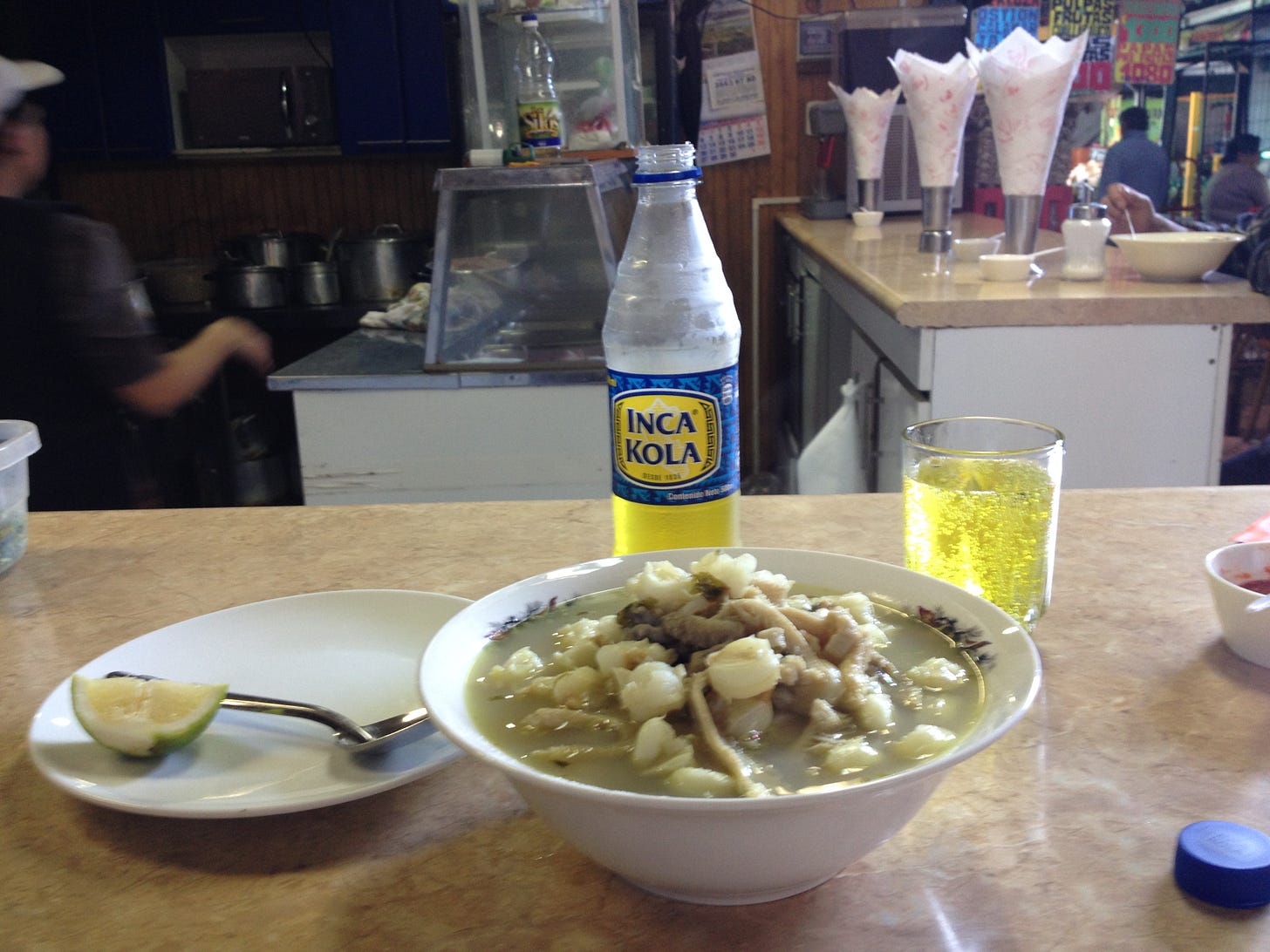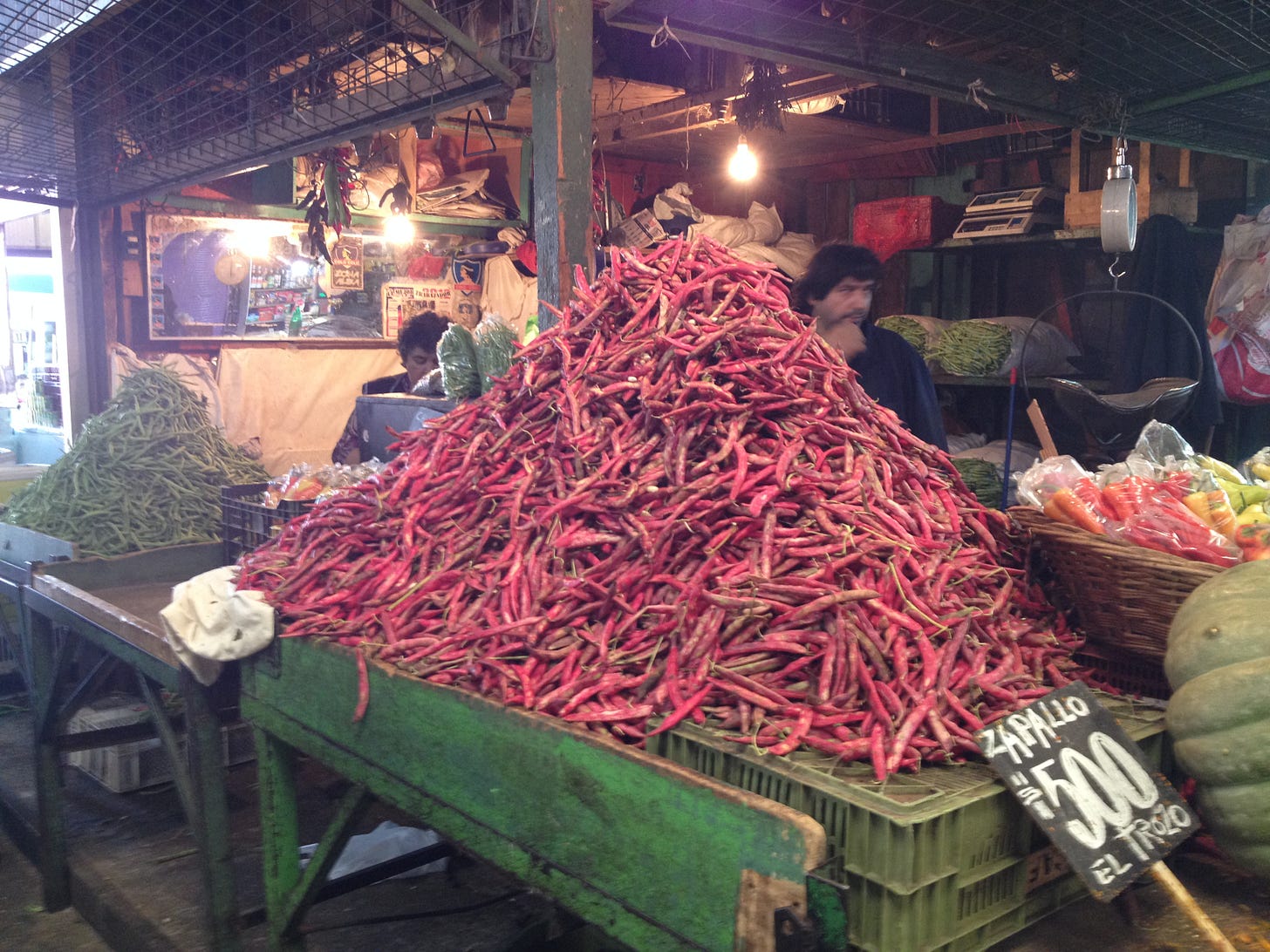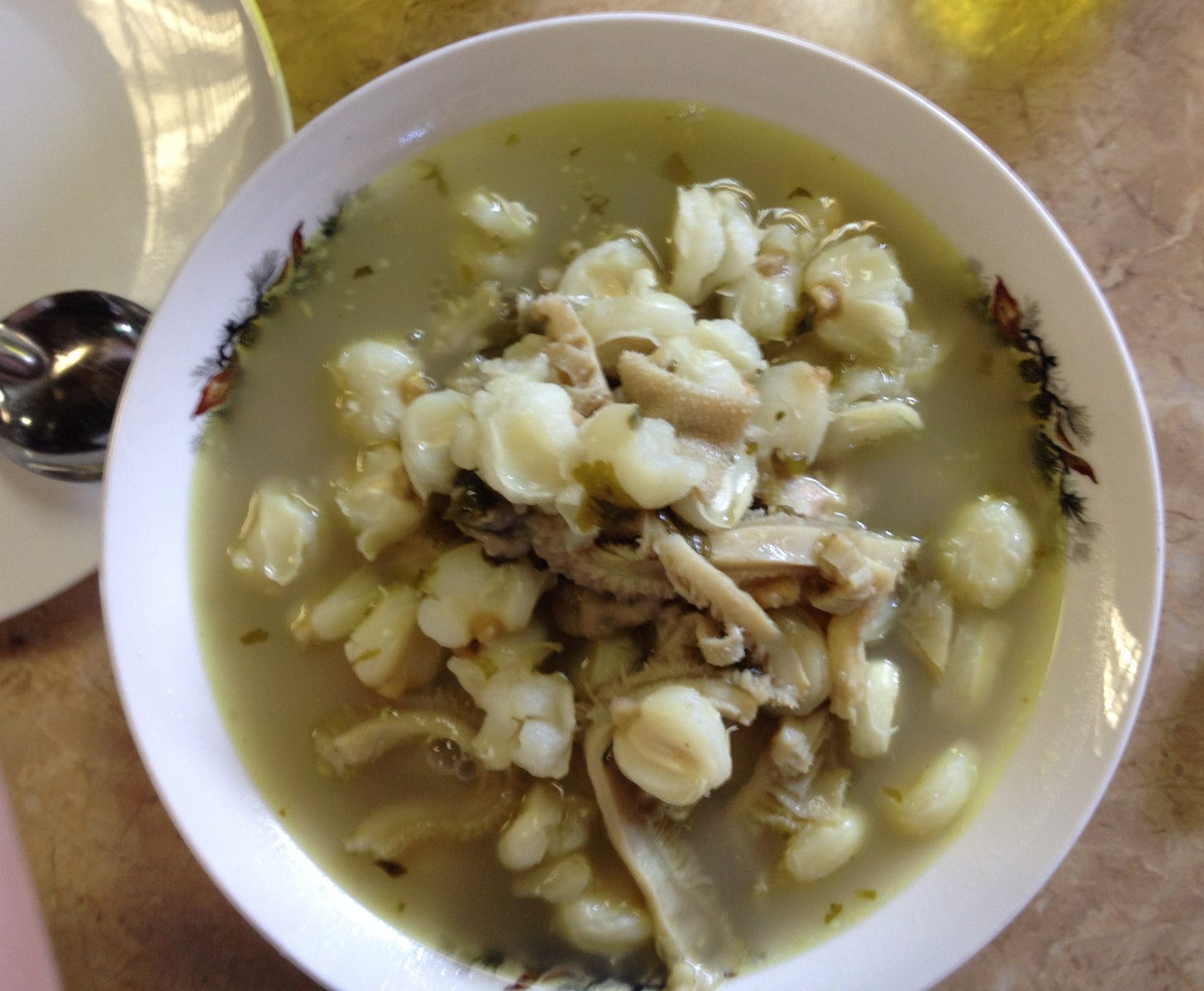Tuesday nights were taco night in Santiago, a chance for a small group of students to come up to our apartment and watch me eat a prodigious number of chicken tacos. Which meant that Tuesday afternoons were spent shopping, a chance for me to wade into the Vega Central and buy a prodigious quantity of food, and perhaps have a meal or two while I was there.
I’ve mentioned the Vega Central in a previous post, and tried to impress on you that this is where Santiagueños of modest means go to buy their food. The middle and upper classes have their American-style supermarkets, but poor people, the frugal and people in the restaurant business head off to the Vega Central. It’s four-plus city blocks of small stalls, stands and wholesalers, jammed together and smelling of rotten fruit; a warren of crowded aisles and hidden passageways. Anything edible that’s produced or imported into Chile is sold at the best prices in the Vega Central.
So, on Tuesdays after class, I would sometimes walk the two miles from the university to the Vega, a pilgrim on the Holy Glutton Way. (I’m not proud of my occasional gluttony, just happy that 21st century Christians have cut two or three out of original Seven Deadly. )
I’m both enamored and appalled by the Vega Central. Enamored because in addition to the hundreds of different stands—from fruit to fish, salted nuts to plastic dishes—there are dozens of tiny restaurants serving up the homiest of home-cooking. Most of them are run by a simple, stout, hard-working woman of a certain age, often referred to as “tia“, “aunt”, who’s the holder of both the secret recipes and the cash box.
I’m appalled, of course, because until you’ve seen your butcher reach his bare hand into a meat case of skinless chicken breasts and shovel two kilos of them into a plastic bag, dripping chicken juice onto every surface, you’ve not lived the Vega life.
On my next to last day in Santiago, after a three months in residence, I made a final trip to the Vega to buy the merkén that would be the gift I would hand out to those at home. I also wanted one last meal, a bowl of patasca (or pataska), a caldo made with pieces of giant hominy, tripe and some vegetables, all floating in a broth made from a cow’s foot, or a sheep or pig’s head. The word patasca means “broken corn”, a reference to the bloated kernels of hominy, which swell and burst open while stewing. It’s mostly thought of as a Peruvian dish, which means it should taste pretty good, as Peruvian food is reliably okay. In Chile, patasca is the regional speciality of San Pedro de Atacama, that touristy/hippie/desert town in the far north.
I had to eat a bowl of patasca in the Vega Central because when I’d been in San Pedro de Atacama, two weeks earlier, I’d been thwarted in that ambition by the fact that the entire town was melting. It had rained three days in a row in the official “Driest Place on Earth”, a freakish series of March thunderstorms which knocked out power, washed away downstream villagers, and was causing all of the adobe buildings to return to the mud from which they had come.
So, trips to tourist attractions were cancelled, the walls of our hostel were crumbling, and I could not find a place to eat a bowl of tripe and hominy soup. The result was a pretty fun mini-vacation and a mild obsession with something you wouldn’t serve your mother-in-law on a dare.
But, I am nothing if not persistent in my dining desires, and patasca was one of the reasons I was at the Vega Central, having failed to find the dish in any of my usual neighborhoods in Santiago. This wasn’t surprising, as most Santiagueños like what they’ve always liked and not much more. Chilean cuisine is a constellation of fixed stars, most of them shining through a fog of mayonnaise and avocado. Patasca had neither, was made from cast-off innards, and was associated with Peruvians and places in Chile that people in Santiago didn’t think about very much.
And, so, off to the Vega.
I expected to find patasca in the Vega because a lot of Peruvians worked, shopped and ate in the Vega. Peruvians are the most prominent immigrant group in Chile, their numbers having tripled over the last 15 years, with as many as 200,000 of them now in the country. The women work as maids and nannies and the men do physical grunt work, agriculture and construction. Chileans like some Peruvian food—ceviche, lomo saltado, sanguiches—but they’re down on the Peruvians, themselves, regarding them as interlopers who take jobs that Chileans should have.
Be that as it may, I wasn’t looking for job-stealing Peruvians, but for patasca, and after wandering the aisles for 45 minutes I found a tiny restaurant with ten seats, the word “patasca” chalked onto a blackboard. I pulled up a chair at the counter and climbed into it. It was too early for lunch, only 11:30 in the morning, but not too early for a pre-lunch snack of offal and hominy.
“What do you want,” asked a middle-aged man in the blue ballcap sitting further down the counter, a stack of receipts piled in front of him. He wasn’t rude, just direct and unsmiling, but I could tell he was a tough character. The two employees, a younger version of the old man—obviously his son—and a woman of who knows of what relationship, were sullen and skittish.
“A bowl of patasca, please, and an Inca Kola.”
Inca Kola tastes like sweetened floor polish, but it’s the “Drink of Peru,” and thus seemed appropriate.
The tyrant jerked his chin and said one word, “patasca”.
Here’s the exact scene thanks to the miracle of cellphone videography.
And there it was, the culmination of my desire for regional peasant food. Bask in its glory…
I scooped up a spoonful and slurped, and learned what you, a wiser person, would have known from just looking at that kitchen and those two sad-eyed people: that Señor Blue Cap’s patasca would be nothing to call home about, unless it was to my insurance agent requesting an emergency evacuation for food poisoning.
It wasn’t actively bad, just much blander and more hominy-er than I would have thought. The tripe was surprisingly muted in flavor and the broth too thin. I wondered if they had actually used a pig’s head, or had skimped on that crucial ingredient. More than anything else, however, that bowl of bland patasca made me desperately want some menudo, with its honeycomb tripe, hominy and blast furnace dose of red chili pepper. Man, I missed Mexican food.
One other thing: I had tried to engage both of the workers and the boss in a bit of banter about the food, but was snubbed.
“This is pork, right? Not sheep?”
“Pork,” answered the younger man.
“Is it hard to get sheeps’ heads in Santiago?”
He didn’t even shrug his shoulders, just stepped away from the counter, moving out of earshot. It didn’t really hurt my feelings. I’m usually ebullient whenever I try a novel dish, even if its flavor is disappointing and the restaurant crummy. But, the fact that no one wanted to chat about the food cast a pall over the feast.
Happily, two seats over, a young Peruvian, who was the only other customer, opened a conversation with me about patasca, Peruvian cuisine in general, and about being a Peruvian worker in Chile.
” They aren’t very friendly, the Chileans. Look at these three here,” he jabbed his fork into the hunk of meat on his plate and sawed at it with his knife, “you should go to Peru. They like people there.”
I didn’t want to argue with my new friend. Chileans can seem sullen and taciturn in public, and it’s rare for one to start a conversation with a stranger, as this Peruvian had done with me, but underneath that, Chileans are shockingly kind and actually look out out for the wellbeing of foreigners. I have more anecdotes than I can count of exactly that behavior.
But, then, I have other anecdotes of the opposite behavior, and this meal ends with one.
I had finished only half the bowl. I got the idea of patasca; no more was required. The bill was 3400 pesos, about five and a half dollars. I gave the young man in the white cap a 10,000 peso note, and a minute later, he returned from the register with a luca and some coins, 1600 pesos. I saw it right away.
“Dude, you’re missing 5,000.”
“Como?”
“5,000”
He stood there, perfectly still. The look on his face told me this wasn’t an honest mistake, but attempted larceny. He was busted and knew it.
“My 5,000 pesos. I’m short 5,000 pesos.”
“Aaahh, ya.” Chileans have this weird way of acknowledging something that’s obviously true, a long “aaaaahhh” followed by a curt Germanic “ja”.
He returned to the register and fetched the missing 5,000 peso note. I wasn’t even angry, more mildly annoyed by the attempt and amused at having caught him. The person who was really enjoying the scene, however, was the Peruvian. He was smiling, and nodding his head. I liked him immensely.
“I might be a gringo,” I said to the crooked counterman, “but I’m not stupid,” and then stepped back to leave, bumping into my chair and knocking it to the floor with a crash, my grand exit ruined.
The Peruvian howled with laughter.
Follow me on Twitter, like me on facebook, and recommend me to your friends. See you on Monday!







This is what your videos did: make me dig out my bag and find out if I had enough money to get off a plane and head to the Vega! I don't but will.
Love this! You, btw, get great dried hominy here. It's not giant though. https://www.ranchogordo.com/